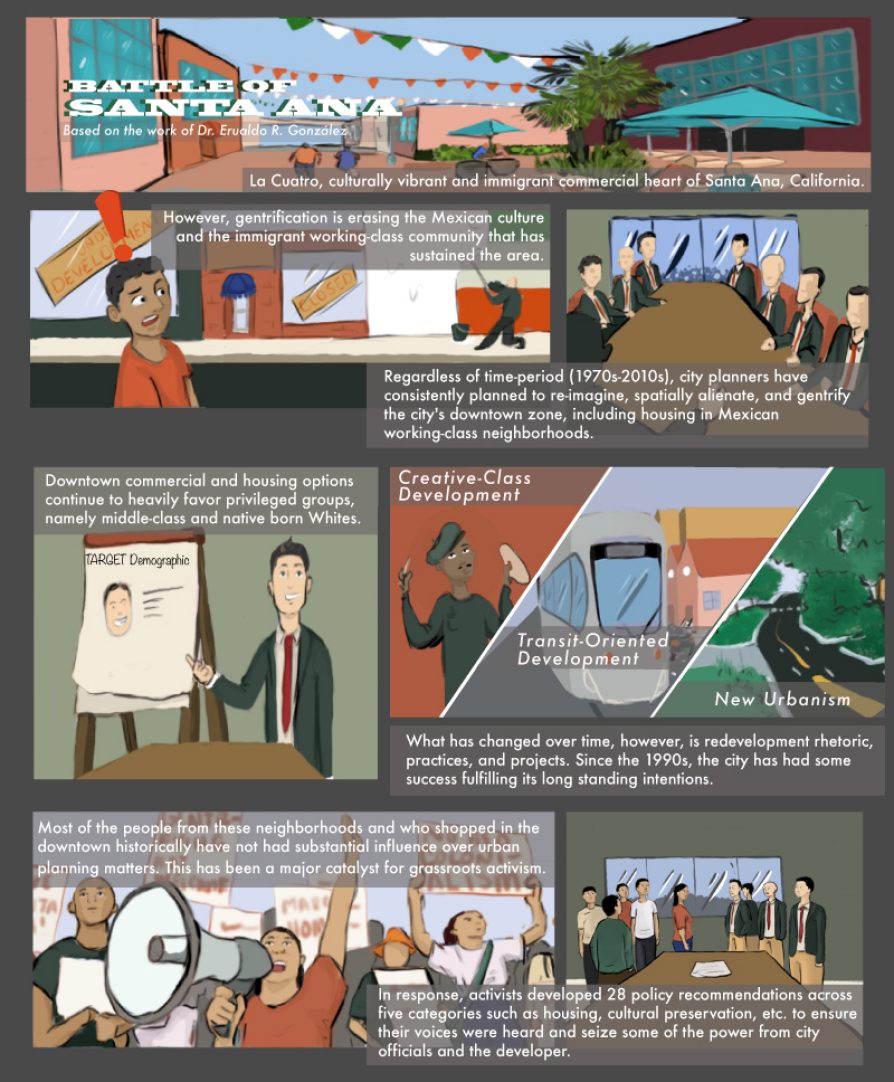- About
- News
- Events
- Initiatives
- Anti-Racism Collaborative
- Change Agents Shaping Campus Diversity and Equity (CASCaDE)
- Diversity Scholars Network
- Inclusive History Project
- James S. Jackson Distinguished Career Award for Diversity Scholarship
- LSA Collegiate Fellowship Program
- University Diversity & Social Transformation Professorship
- Publications & Resources
- About
- News
- Events
- Initiatives
- Anti-Racism Collaborative
- Change Agents Shaping Campus Diversity and Equity (CASCaDE)
- Diversity Scholars Network
- Inclusive History Project
- James S. Jackson Distinguished Career Award for Diversity Scholarship
- LSA Collegiate Fellowship Program
- University Diversity & Social Transformation Professorship
- Publications & Resources

Scholar Story: Doug Meyer
July 17, 2018
Scholar Story: Allison Skinner
August 27, 2018Scholar Story: Erualdo González
"Gentrification and displacement are rampant in many cities where working class and communities of color have lived historically." —Erualdo González
Why do certain neighborhoods gentrify and others don't? Some experts will point to disinvestment in the community. Others say the working class of an area are simply displaced when middle class people move in.
According to Erualdo González, there’s more going on than meets the eye. “I'm not really interested in the hipster, I'm more concerned with city officials and private and public partnerships that create the spaces and the opportunities for those hipsters to be there in the first place."

Dr. González is a professor of Chicana and Chicano studies at California State University, Fullerton. His scholarship focuses on community development, neighborhood planning, planning and health, and urban governance and policy. In particular, he explores how gentrification happens, and the models of grassroots resistance and response to it.
In April 2018, my curiosity was piqued by his book, “Latino City: Urban Planning, Politics, and the Grassroots.” I caught up with Dr. González to learn more about his scholarship on this topic.
This interview has been edited for clarity and length.
What is the focus of your recent book, Latino City: Urban Planning, Politics, and the Grassroots?
It's a critical analysis of community development and gentrification, as well as the politics and grassroots resistance that come with it. I explore the extent to which city urban plans, projects, city and city stakeholder elites, and popular media have shaped and attempted to do away with downtown cores — areas that are relatively affordable, working class, and ethnically diverse.
Gentrification and displacement are rampant in many cities where working class and communities of color have lived historically. My scholarship covers these everyday experiences and how they happen.
Why Santa Ana, California?
I am from the city of Santa Ana, born and raised. I was living there during the time period that I examine in the book, and I grew up in a downtown area because that’s where my mom worked in the 70s-90s. I have a particular affinity and understanding of the area.
Something unique about Santa Ana is that it is one of the most Latino, Mexican, and immigrant populated cities in the United States, and it became the first all Latino city council in the mid 2000s of a major US city. Yet it was during that time period where we start to see accelerated gentrification in the downtown core.
The city was getting a lot of national coverage in New York Times and example even had a headline, “In Santa Ana, New Faces and a Contentious Revival.” The redevelopment vision began in the 1970s where the city council and city officials were virtually all white, and the downtown was brown. Fast forward to the 2005-2006 time period, we have a different power dynamic in terms of city council now that it is all Latino, yet the downtown is now much more immigrant, Mexican, and working class than it was in the 70s. I think tracing redevelopment across time was something that was really interesting to see.
What concepts shaped this book?
The concept that I wanted to focus on was the concept of spatial alienation. I treat the concept of spatial alienation to mean redevelopment that intends to improve urban areas. Spatial alienation defines blight areas and reduces to invisibility an already marginalized demographic and seeks to drive that demographic out of sought after areas for more desirable demographic groups. I use this concept to help focus my analysis.
Gentrification is part of spatial alienation. I look at archival material, namely city redevelopment plans and reports and language and how they define blight across time. But, I also explore what these plans do or don’t do in practice to marginalized communities. What does it look like to reduce invisibility of groups that are already marginalized? What does that mean?
What did you discover in your analysis?
In the 1990s, we start to see city-subsidized arts-led redevelopment and middle class type businesses to attract the creative class of professionals. These are professionals who work in the knowledge-based economy (such as entrepreneurs, computer programmers, legal services, etc.). This type of phenomenon was described in Richard Florida’s 2002 book, The Rise of the Creative Class, and in Santa Ana, we see this creative class redevelopment happening about a decade before Florida’s book.
Fast forward to the 2000s where now we start to see the city experimenting with transit oriented development ideas in central historic downtown cores, where you want to get people out of their cars and ride the light rail, in which working class communities of colors are often displaced.
I also see in Santa Ana that the city used a third model to help spatially alienate and gentrify. The third model is new urbanist redevelopment, which deals with recreating zoning codes to allow for mixed-use loft redevelopment in certain areas. It’s about making the city more compact.
In short, I chronical how these three models have overlapped to help produce gentrification in the downtown area, focusing on the commercial aspect of gentrification. In respect to state-sponsored initiatives, the grassroots working class have proactively questioned the city's lack of power-sharing over redevelopment decisions. The initiatives that have been supported through private-public partnerships, those are the ones that are clearly gentrifying.
What were some of the things that grassroots organizations did to have their voices heard or to seize some of the power?
I was involved with the Santa Ana Collaborative for Responsible Development (SACReD) when it began and we decided that the best way to address gentrification and displacement was to lobby the city to pass a community benefits agreement (CBA). We had 28 policy recommendations and all of them fell under five different categories (for example, social cultural preservation, small business, housing, safety, etc). The recommendations were our best effort to respond to a standard city feedback to us, which was along the lines of, "You are against something, but how are you going to be for something else? What are your specific recommendations and then how is it going to get paid for?"
As a legal binding agreement between the developer, the city, and the “community,” we thought a CBA was the best way to move forward. To be concrete with what we what, and to hold developers in the city accountable to those agreements.
While the CBA did not pass, there were some victories that ensued from it. For example, SACReD pushed to redefine “affordable housing.” Santa Ana is in Orange County, which historically has been one of the wealthiest counties in the United States. When you use the median income of a county to define housing affordability, even middle to upper middle class families will probably have a hard time purchasing a new home.
What are the key takeaways of your work?
Regardless of decade and changing redevelopment rhetoric practices and projects, city planning has been designed to reimagine the majority downtown center of Mexican neighborhoods and its commercial heart, La Cuatro, and to whiten and gentrify.
Commercial and housing options continue to heavily favor materially and culturally privileged groups, namely middle class and native born whites. We also find that select groups of Latinas/os — a middle class mix of political elites and Latino creative class types — have more recently contributed to the city's long standing gentrification visions.
You have to look at redevelopment critically. I think that's the main thing. And we have to ask ourselves, whoever we are, are we scholars, are we activists, are we just everyday people in the city? Or, are we a combination of these at any point in time? What is our role in these changes that we're seeing?
Are you interested in Dr. González’s work? Feel free to reach out to him. He's interested in connecting with scholars working on research related to an interest in the topics of urban planning, community development, gentrification, displacement. Visit his profile here.




